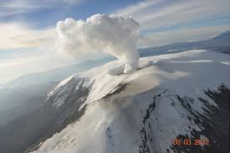

Nevado del Ruiz, Colombia
On 13th November 1985 at 9:09pm, there was a small eruption at the glacier-capped summit of the volcano Nevado del Ruiz erupted. The eruption reached 3 on the Volcanic Explosivity Index. Ash had been falling all day before the eruption but stopped between 5:00pm and 7:00pm. When the ash fall ended officials in the area ordered people to stay calm and remain indoors, ignoring the scientists orders to evacuate. To make matters worse a storm hit that evening, which caused power cuts, disabled communications, and also blotted out the sound of the eruption.
Nevado Del Ruiz is part of the Andes mountain range and is situated in Colombia, South America. The volcano’s last eruption happened over 140 years ago and because of this it was nicknamed ‘The Sleeping Lion.’ Many townspeople did not even realise that the volcano even existed. The amount of seismic activity near Nevado del Ruiz had been increasing since November 1984. However the scientists struggled to predict when the volcano was actually going to erupt and due to too many false alarms the locals began to ignore their warnings, even the Colombian government criticized them for trying to scare people.
The eruption caused lahars, a mixture of ash and water, which moved down the river valley at 40mph towards the town of Armero. Armero lies 40km away from the volcano in the Langunillas river valley. Most people were immediately killed and buried under 15ft of mud, which also buried 80% of the town’s buildings. It was Colombia’s deadliest known lahar, killing over ¾ of the town’s 28,700 people. The lahar also damaged 6,000 acres of crops, killed livestock, and destroyed parts of the agricultural infrastructure, as well as much prime farmland. Altogether the mass of erupted materials was 35 million tonnes.
A poor rescue effort resulted in many more people dying when they could have been saved. For example, the rescuers requested a pump from Bogota to help rescue a 13 year old from the mud, but when it finally arrived it was broken and the child died after 3 days stuck in the mud. Helicopters, which struggled to fly in the thin mountain air, sometimes flew in journalists instead of vital equipment. Overall, 50 school facilities and many teachers were lost, as well as two entire hospitals and all their equipment. This meant that there wasn’t a sterile environment for injured people. There was a 50% decline in economic activity in the 3 months after the disaster; this was mainly due to the contamination of the river by the lahar, which affected the local fishing industry. Due to the eruption, a new system, using Acoustic Flow Monitors, has been put in place to detect lahars and give the warning to evacuate. In total the eruption killed 23,000 people, injured 5,000 and destroyed over 5,000 homes.
The eruption resulted in the deaths of so many people, firstly because despite the fact that Armero was known to be at a high risk of lahars, people ignored the warnings of the scientists and didn’t put up any lahar defences. Secondly, the storm which hit at the same time as the eruption meant that Armero didn’t get the warnings from officials of other nearby towns. Thirdly, the officials told people to remain indoors during the eruption and yet the lahar buried 80% of buildings. Finally, the poor rescue effort of the people who managed to survive the lahar resulted in survivors dying simply because they were stuck in the mud.
image- https://volcano.si.edu/showreport.cfm?doi=10.5479/si.GVP.BGVN201208-351020

0 Comment:
Be the first one to comment on this article.